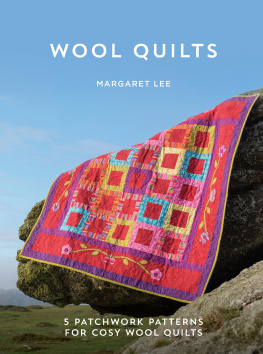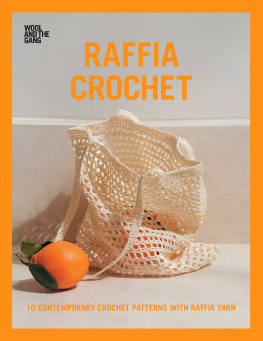
Discover more fresh Craft books, eBooks, and inspiration for your next project!
With detailed, step-by-step photos and clear instruction, Stackpoles craft titles show both beginning and experienced crafters exactly how-to!
Visit
Stackpole Books Crafts & Hobbies webpage

Acknowledgements
Picture credits
We would like to thank the following for their kind permission to reproduce their photographs: Alison Casserly 38; Amanda Crawford 55; Amanda Jones 48; British Wool Marketing Board 6 bl, 12 bl, 15, 16 br, 20, 25, 32, 44, 46 br, 67, 75, 96, 101, 103, 109, 115, 131 br; Diana Alderson 80; Diana Steriopolis 14, 89; Dominic Heneghen 52, 54; Douglas Bence 7, 19 br, 112, 117 br; iStock 8 bl, br, 9 bl, 10 bl, 11 tr, 132, 134 bl, 138; Jane Dansie 123; Jennie Martin 49; John Eveson 9 br, 58; Julie Halliday 1, 39; Karen Marshalsay 127; Linda Lunn 79; Myra Mortlock 36; Rita Taylor 65; Sam Morgan Moore 2, 3, 4, 6 br, 8 background, 13 tl, 13tr, 16 c, 17, 18 background, bl, br, 19 bl, bc, 21 inset, 22, 23, 24, 26 inset, 27, 28, 30, 33 inset, 34, 35, 40 inset, 41, 42, 43, 45 inset, 46 bl, bc, 47, 49, 50, 51, 53 inset, 55, 57 59 inset, 60, 61, 62, 64, 65, 66, 68 inset, 69, 70, 72, 73, 76 inset, 77, 78, 79, 81 inset, 82, 83, 85, 86, 88, 90 inset, 91, 92, 97 inset, 98, 99, 102 inset, 10, 104, 110 inset, 111, 116 inset, 117 cr, 118, 119, 122, 124 inset, 125, 126, 130 background, bl, br, 131 bl, tr, 136; Sarah Shourie 72; Sasha Kagan 118; Sian Brown 126; Simon Pask 21, 26, 33, 40, 45, 53, 59,68, 76, 81, 90, 97, 102, 110, 116, 124; Tina Barrett 31, 131 bc; Vampy 56.
Abbreviations: bl bottom left, br bottom right, c center, tl top left. tr top right.
Authors acknowledgments
I would like to thank the everyone who has contributed to this book. The photographers Sam Morgan Moore, Douglas Bence, Diana Alderson, Diana Steriopolis, Dominic Heneghen, John Eveson, Simon Pask and Julie Halliday; models Andrea, Katie, James, Finley, Sam and Miles; all the designers and knitters; and the patient editor and designer Julie Brooke and Louise Turpin.
I have written this book by standing on the shoulders of giants, people such as Robert Bakewell, who created the modern Leicester breed and Jo Henson, who saved the Castlemilk Moorit from extinction. I have also consulted the work of specialist writers of much more detailed, informative and better researched books on wool and yarns, a selection of which are listed in the bibliography.
I owe a debt to my mother who loved wool cloth, and probably taught me to knit (I cannot actually remember learning to knit, although I remember learning to read and write) and who knitted all our pullovers; to my own Ambler ancestors, who by working in the worsted trade in Bradford led me to understand that running a wool mill is a possibility; to Barbara Willis and Jane Deane who taught me to spin, and to the many in the wool trade, particularly Bob Armitage, Richard
Brown and Robert Hirst, who, despite their misgivings about a woman starting a wool mill in Cornwall, have been unfailingly supportive.
I must also thank my whole family and the many friends, but especially Douglas my husband and Sam our son, for putting up with the whole sheep and wool obsession, looking after the sheep, modelling the clothes, picking up the pieces, cooking the meals, and helping to drink the wine.
Contents

Pure Wool Philosophy
The importance of using pure wool from specific breeds representsa passion and faith, as well as a philosophy. There is logic behind thispassion and faith. You may be reading this because you feel the same way,but it is worth going over the basics, if only to help you to convince others!
The Campaign for Wool, and its patron, HRH The Prince of Wales, remind us that wool is:
100% natural: the fiber is not artificially made in oil refineries and chemical plants
100% renewable: sheep grow the wool every year for many years
100% sustainable: sheep live on land that cannot be managed and where crops and other animals cannot survive: high hills and fells, steep downlands, and, in some cases, even woodlands. For example, the White-faced Woodland sheep breed does not eat trees, unlike my Gotland sheep!
100% biodegradable: wool will rot back into the soil. However, this takes some time, and it is possible to store fleeces for three to four years. It can also be recycled
warmer: it both insulates and permits the passage of air, so it can keep you warm and still be breathable
safe: unlike cotton, igniting at 255 centigrade, and artificial fibers, variously 420-560, wool does not catch fire until it reaches 600 centigrade
hypoallergenic: it resists dirt and stains and the accompanying germs, so wool needs washing less than other fibers
a part of our historic landscape. Imagine Britain without fields of sheep
being used less, partly causing sheep numbers to have halved in twenty years

The logo of The Campaign for Wool (left) and its patron HRH Prince Charles (below left). Baby Finley tries a Blue-faced Leicester blanket.

Why wool for me?
Since learning to knit at around five years of age, and being involved with sheep since 1997, I have come on a long journey:
I discovered that all sheep owners believe their own sheep are the best, and they rarely have diseases or defects. I also discovered Gotland sheep. While they need a bit more care and are more suited to small flocks, they are determined to stay alive and healthy.
I found that sheep are intelligent with good memories (now the subject of research). One of my sheep, Jake, spent 30 minutes trying to break into the chicken house to get the grain, which suggests a degree of concentrationhe was also working on the door catch, not any other part of the house. Its just that a set of teeth is not as good as a human hand!
I also discovered that wool is very rewarding, not just for the reasons above, but because it feels wonderful. There is a substance to wool which is hard to define. It is stimulating and rewarding to knit; calculating, experimenting, and watching the work grow. It is obvious to me, and now also to you I hope, that the arguments about and loveliness of natural wool should go hand-in-hand to sustain a future for both wool and sheep.

Somehow, I ended up with a breeding flock of Gotlands. I am starting to breed black Blue-faced Leicesters, and I run The Natural Fibre Company. This is not a lifestyle activity but a real business, with real people, products and results which are enthralling! The Natural Fibre Company is especially rewarding because its customers are so knowledgeable and interested in wool.
Next page













